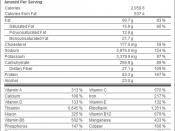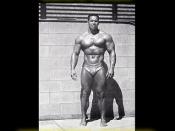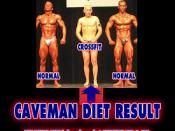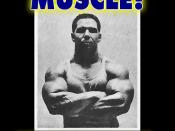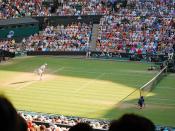The individual taken in consideration during this course is a 17 year old tennis player, about 5ÃÂ10ÃÂÃÂ or 1.80 Cm. weighting 170 pounds or about 77 Kg.
Tennis requires broad endurance capacity, with an ability to perform short bursts of high-intensity exercise combined with stages of lighter intensity or also rest. It is common for tennis matches to last one to 4 hours and played in very hot and humid conditions (1). Modern tennis players have become power athletes and have developed structures where muscles and power in general are necessary to keep up with the pace of the contemporary game. Unlike sprinters who must have a majority of type 2 muscle fibers, or endurance athletes who must have a majority of type 1 muscle fibers, tennis players have been shown to be varied between being either predominantly fast or predominantly slow fiber-type athletes (2). The body fat percentages of most tennis players are considered low when compared with the general population.
It is recommended that tennis players would have a body-fat percentages of <12% for males and <23% females. Tennis players, due to the start-stop discontinuous nature and inconsistent length of play, have a complex nutrition physiology. According to the literature, it is my understanding that recommendation about protein intake for athletes varies according to the sources but also according to the researcherÃÂs opinion (3). I found this topic to be controversial and somewhat confusing. Muscle tissue is about 15 to 20 percent protein, in order to maintain the power and the strengths, modern tennis players need to pay attention to protein intake. Protein intake for athletes would vary according to the type of exercise, length of the exercise session and outside weather conditions. Protein intake should be calculated and taken very seriously because the amount not utilized by the body, is stored as carbohydrate or fat. My daily recommendation for my athlete, according to his age, gender, and type of training, would be of about 1.2-g/kg, between 90 and 95 grams of protein (5, 6).
If my athlete were a vegan, I would slightly modify my recommendations, taken in consideration other variables. A vegetarian diet is a plant-based diet that consists of fruit, vegetables, nuts, seeds, grains, and legumes. According to the literature, it seems that there are many different vegetarian diets. The ÃÂveganÃÂ diet is one of the two main types. The true vegan avoids all animal products and often shoes a deficiency of vitamin B12, vitamin D, calcium and zinc (8). The ADA opinion on vegetarian athletes (all types of vegetarian including vegans) is that they are able to obtain all the proper nutrients and proteins from plant-based foods (8, 10). When comparing the different opinions and different suggestions of the various national associations, it seems that there is not a unified vision on this subject (10).Because additional research is needed in order to verify if indeed vegans lack nutrients, my position and my suggestion for the tennis player would not be modified if the above-mentioned player were a vegan. The only advice I would add would be to take additional supplements and vitamins and to also consume an assortment of grains, vegetables, legumes, and seeds during the day, so that if one food has a deficiency in a particular element, another food will make up this deficit (9).
2b. If my athlete were on such low caloric diet, I would make major changes in the way he would train. This caloric deficit would make the athlete loose 1-2 pound per week. Due to this, it would be necessary to increase the amount of protein intake to approximately 2.0 g/kg/day. This would help with the proper intake of amino acids. In order for the tennis player to maintain a good energy level, the CHO intake should also be modified and increased to between 9-12 g/kg/day. A question that should be answered would be the reason as to why the athlete would be in a 500-1000 calorie per day diet. If this would be due to extreme training, then some changes would be made in that direction. I would like to add that if the athlete would be on such a low calorie diet for a prolonged amount to time, I would seriously consider changing the duration of the training, intensity, and even the frequency (11).
A popular assumption about high-protein diets concerns the excess carbohydrate intake that supposedly would produce elevated insulin levels, which in turn promote storage of body fat (4). Power athletes tend to consume high protein diets. A power athlete consuming 3 g/Kg of protein per day in a eucaloric state causes a buildup of toxic ketones. These types of diets are known as ÃÂketogenic dietsÃÂ and can lead to kidneys problems. This is due to the fact that kidneys would need to work in excess in order to flush out the ketones from the body. The kidneys while trying to expel these toxic ketones, would also eject a significant amount of water, which could lead to dehydration (7). With such a eucaloric diet, carbohydrates would also be affected in terms of quantity. By adding more CHO intake to the daily diet, the power athlete would increase performance and would also assist the muscles with glycogen storage (11, 12).
References:1. Davey PR, Thorpe RD, Williams C. Simulated tennis match play in a controlled environment. J Sports Sci 2003; 21: 459-672. Mero A, Jaakkola L, Komi PV. Relationship between muscle fibre characteristics and physical performance capacity in comparison of trained athletic boys. J Sports Sci 1991; 9 (2): 161-713. Davey PR, Thorpe RD, Williams C. Fatigue decreases skilled tennis performance. J Sports Sci 2002; 20: 311-84. Borsheim, E., M.G. Cree, K.D. Tipton, T.A. Elliott, A. Aarsland, and R.R. Wolfe. Effect of carbohydrate intake on net muscle protein synthesis during recovery from resistance exercise. J. Appl. Physiol. 96:674-678, 2004.
5. McCarthy-Davey PR. Fatigue, carbohydrate supplementation and skilled tennis performance. In: Haake S, Coe AO, editors. Tennis science and technology. Oxford: Blackwell, 2000: 333-406. American Dietetic Association. Fueling Tennis Players (handout). 2006.
7. Burke L. Nutrition for recovery after training and competition. In: Burke L, Dean V, eds. Clinical sports nutrition. McGraw-Hill Companies, Australia, 2006; 415-453.
8. Messina V, Mangels R, Messina M. The Dietitian's Guide to Vegetarian Diets, 2nd ed. Sudbury, MA: Jones and Bartlett Publishers, 2004.
9. Cox G. Special needs: the vegetarian athlete. In: Burke L, Deakin V, editors. Clinical sports nutrition. Sydney (NSW): McGraw-Hill, 2000: 656-7110. Position of the American Dietetic Association and Dietitians Canada. Vegetarian diets. J Am Diet Assoc 2003; 103 (6): 748-6511. Wilson J, Wilson G. Contemporary Issues in Protein Requirements and Consumption for Resistance Trained Athletes. Journal of International Society of Sports Nutrition. 2006.
12. Phillips, Stuart M.; Moore, Daniel R. & Jason E. Tang (2007). A Critical Examination of Dietary Protein Requirements, Benefits, and Excesses in Athletes. International Journal of Sport Nutrition and Exercise Metabolism (IJSNEM). 17, S58-S76.
